Optical Design of Compact Space Autonomous Docking Instrument with CMOS Image Sensor and All Radiation Resistant Lens Elements
Abstract
1. Introduction
2. Specification of Camera Module and Radiation Resistant Material
- : Hyperfocal distance (mm);
- : Effective focal length (EFL);
- f–number;
- : Circle of confusion (CoC);
- Near focus limit (mm);
- : Object distance (mm);
- : Far focus limit (mm);
3. Optical Design and Simulation
4. Conclusions
Author Contributions
Funding
Acknowledgments
Conflicts of Interest
References
- Miranda, D.J. TX10: Autonomous Systems. In 2020 NASA Technology Taxonomy; NASA: Washington, DC, USA, 2020; pp. 115–117. [Google Scholar]
- Bandyopadhyay, S.; Foust, R.; Subramanian, G.P.; Chung, S.-J.; Hadaegh, F.Y. Review of formation flying and constellation missions using nanosatellites. J. Spacecr. Rockets 2016, 53, 567–578. [Google Scholar] [CrossRef]
- Fehse, W. Sensors for rendezvous navigation. In Automated Rendezvous and Docking of Spacecraft, 1st ed.; Rycroft, M.J., Shyy, W., Eds.; Cambridge University Press: New York, NY, USA, 2003; pp. 267–279. [Google Scholar]
- Tsai, D.; Nesnas, I.A.D.; Zarzhitsky, D. Autonomous vision-based tethered-assisted rover docking. In Proceedings of the 2013 IEEE/RSJ International Conference on Intelligent Robots and Systems, Tokyo, Japan, 3–7 November 2013; IEEE: Tokyo, Japan, 2013; pp. 2834–2841. [Google Scholar]
- Pirat, C.; Ankersen, F.; Walker, R.; Gass, V. Vision based navigation for autonomous cooperative docking of CubeSats. Acta Astronaut. 2018, 146, 418–434. [Google Scholar] [CrossRef]
- Smith, G.H.; Hagerott, E.C.; Scherr, L.M.; Herkenhoff, K.E.; Bell, J.F., III. Optical designs for the Mars’ 03 rover cameras. In Current Developments in Lens Design and Optical Engineering II, Proceedings of the SPIE, International Symposium on Optical Science and Technology, San Diego, CA, USA, 5 December 2001; International Society for Optics and Photonics: San Diego, CA, USA, 2001; Volume 4441, pp. 118–131. [Google Scholar]
- IMEC Report. GSTP/ASCMSA/Integrated Radiation—Tolerant Imaging System—Identification of CMOS Imager Applications in Space; P60280–MS–RP–001, Issue 0.1; IMEC: Leuven, Belgium, 1997; pp. 5–15. [Google Scholar]
- Rizzolo, S.; Goiffon, V.; Corbière, F.; Molina, R.; Chabane, A.; Girard, S.; Paillet, P.; Magnan, P.; Boukenter, A.; Allanche, T.; et al. Radiation hardness comparison of CMOS image sensor technologies at high total ionizing dose levels. IEEE Trans. Nucl. Sci. 2018, 66, 111–119. [Google Scholar] [CrossRef]
- Huffman, W.; Thompson, D.R.; Bue, B.; Castillo–Rogez, J.; Boland, J. Autonomous Onboard Point Source Detection by Small Exploration Spacecraft. Publ. Astron. Soc. Pac. 2015, 127, 1279–1291. [Google Scholar] [CrossRef]
- Imaging, A. 1/2.5–Inch 5Mp CMOS Digital Image Sensor; Rev, F., Ed.; Aptina Imaging: Singapore, 2005; pp. 1–46. [Google Scholar]
- Ray, S.F. Applied Photographic Optics: Imaging Systems for Photography, Film, and Video, 1st ed.; Focal press: London, UK, 1988; pp. 164–211. [Google Scholar]
- SCHOTT Radiation Resistant Optical Glasses. Technical Documents—TIE’s. Available online: https://www.us.schott.com/advanced_optics/english/knowledge-center/technical-articles-and-tools/tie.html (accessed on 2 May 2020).
- OHARA Optical Glass Information. Optical Glass Cross Reference Sheet. Available online: https://www.oharacorp.com/pdf/cross-ref-2020-01-opt.pdf (accessed on 2 May 2020).
- Synopsys, in CODE V Documentation Library; CODE V® Synopsys: Mountain View, CA, USA, 2019.
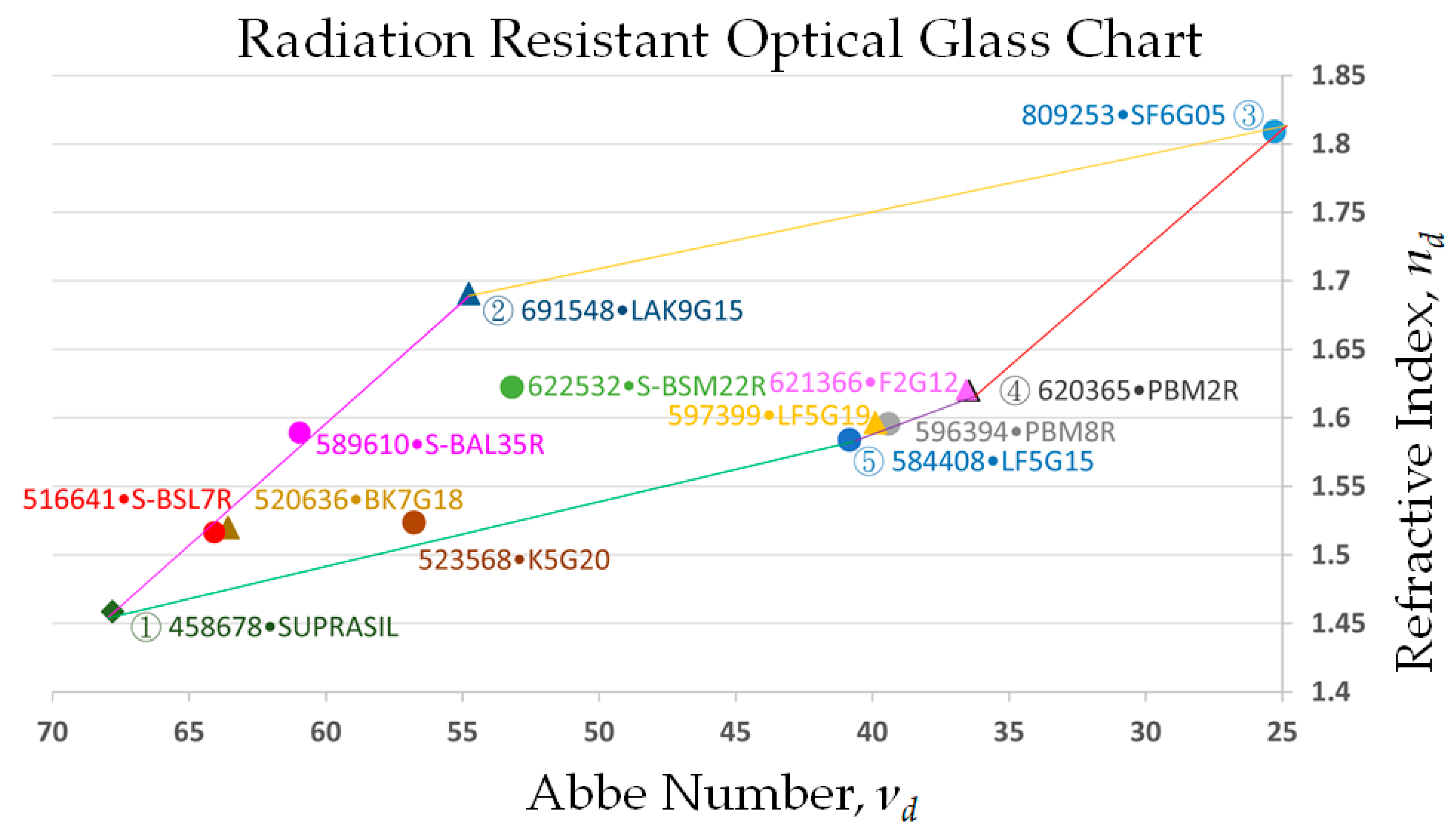
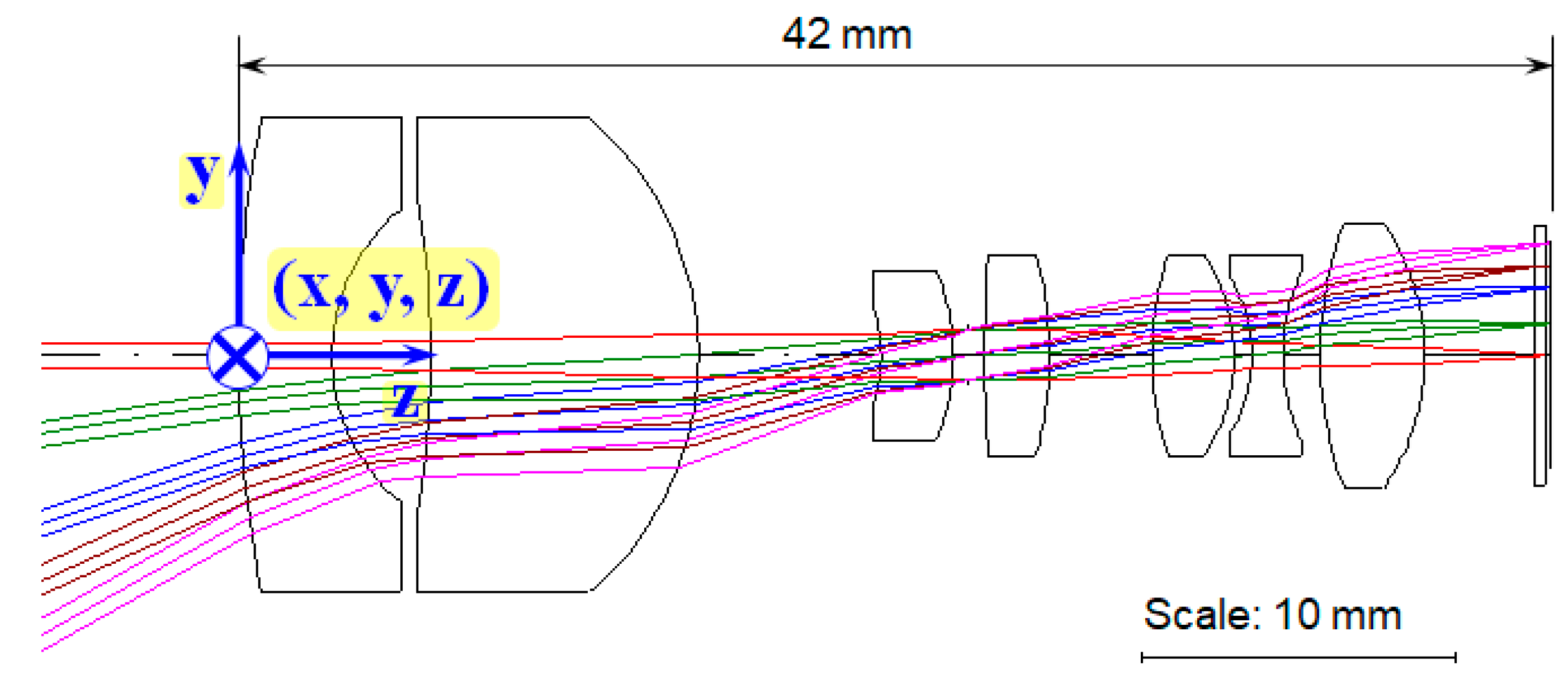
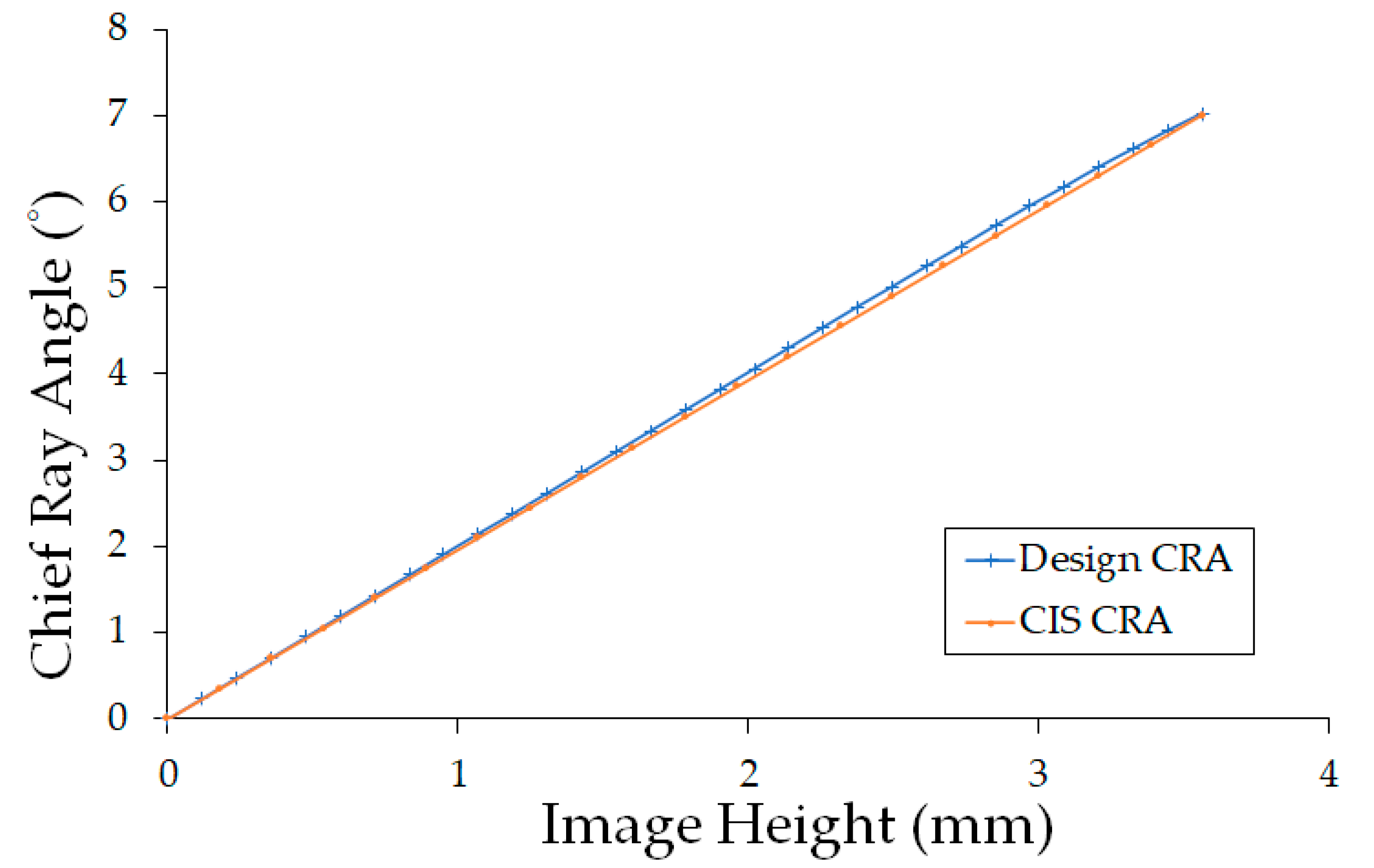
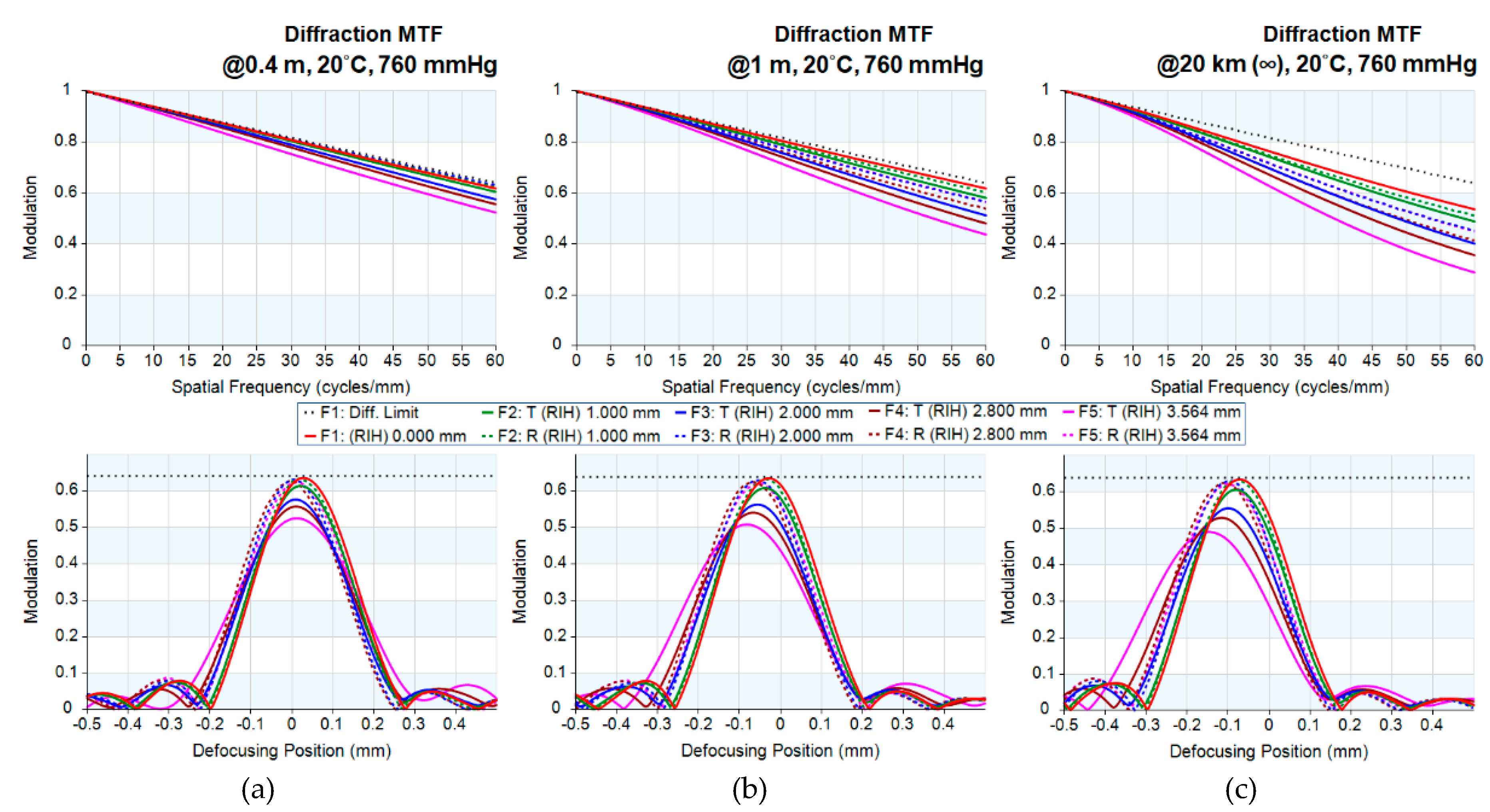
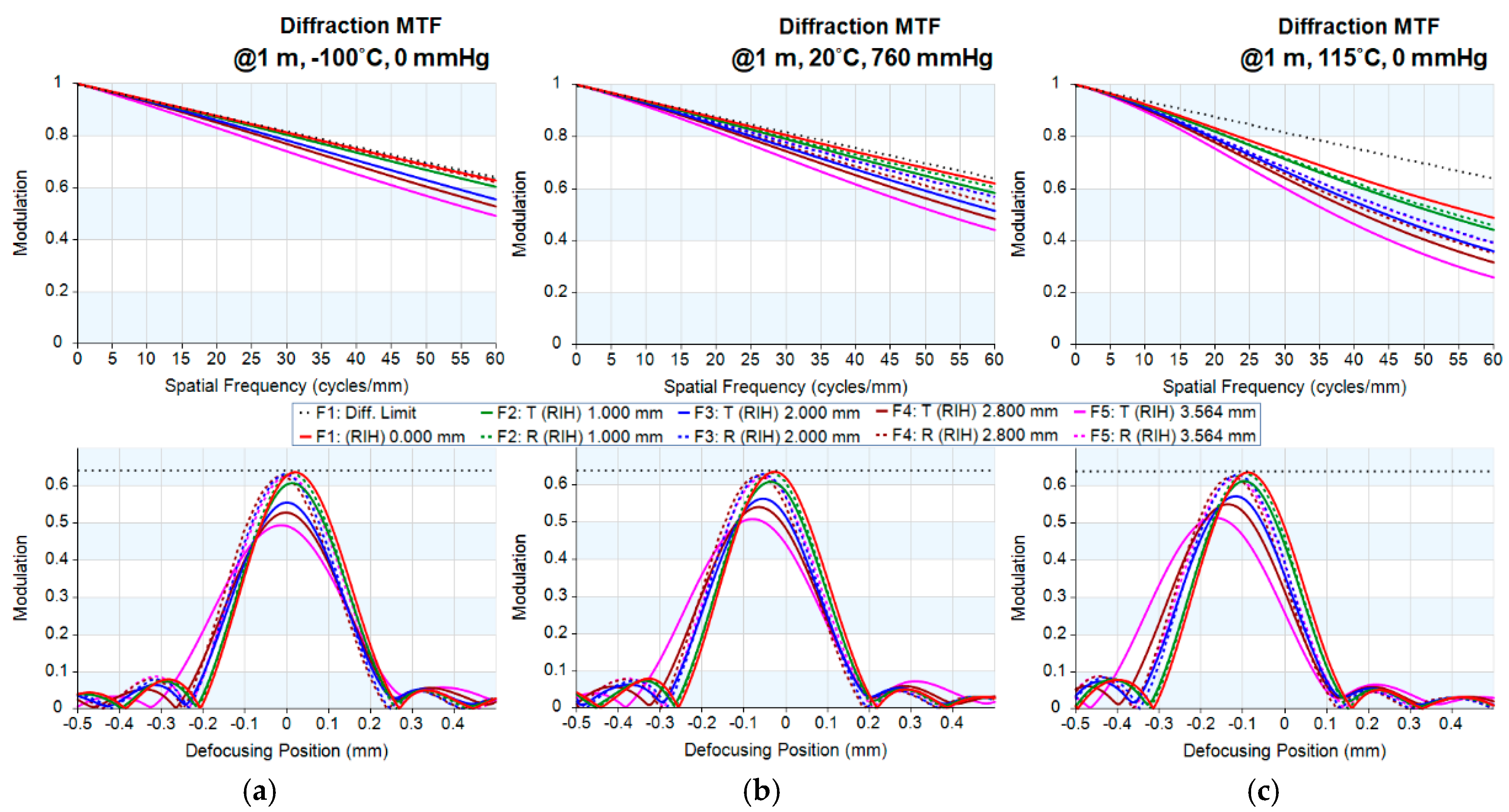
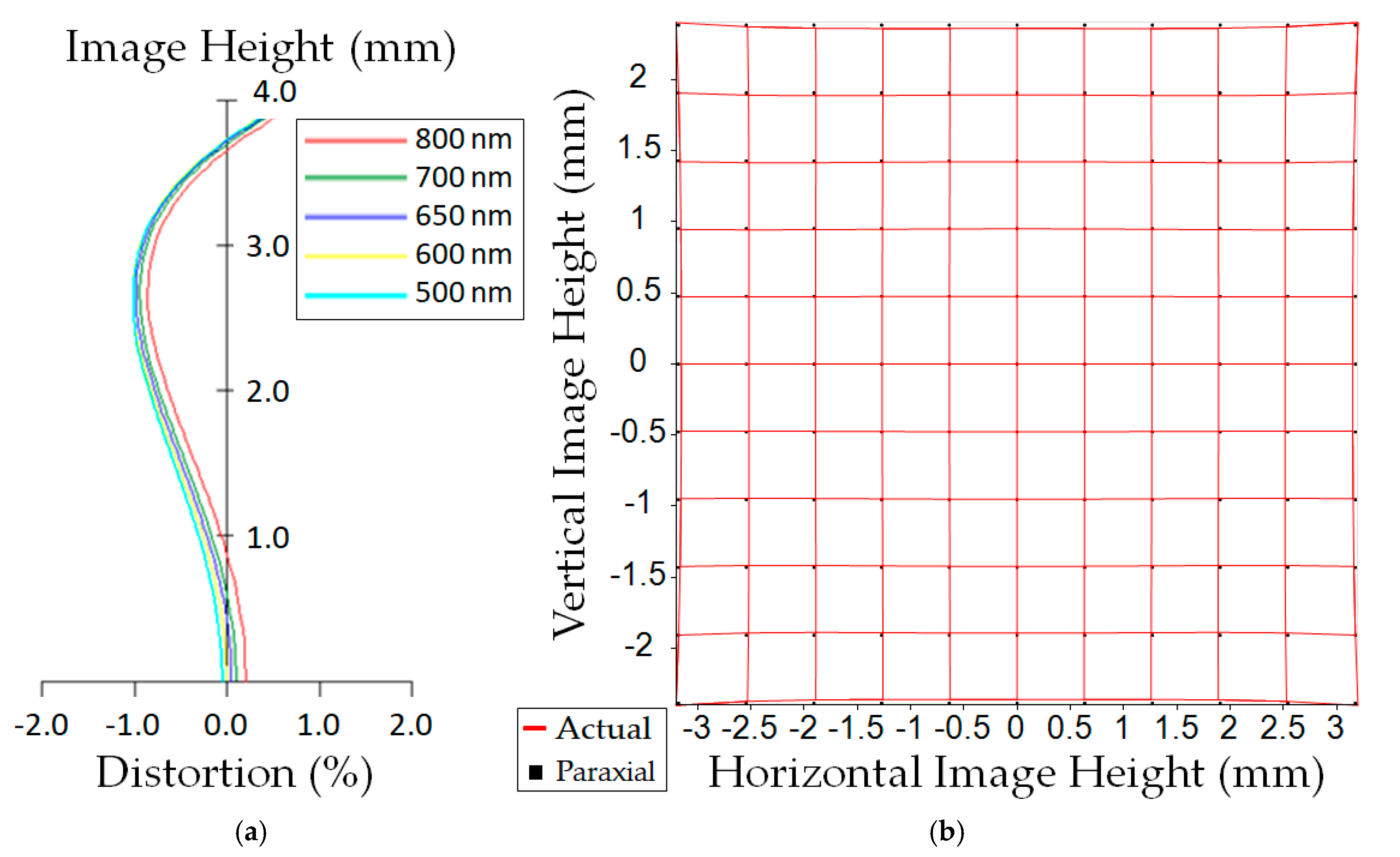
| Parameters | Value |
|---|---|
| Optical Format | 1/2.5 inch (4:3) |
| Active Pixels | 2592H × 1944V (640 × 480, with binning) * |
| Pixel Size | 2.2 μm × 2.2 μm |
| Active Imager Size | 5.70 mm(H) × 4.28 mm(V), 7.13 mm diagonal |
| Chief Ray Angle (CRA) | ≦7° Max. |
| Operating Temperature | −30 °C to +70 °C |
| Properties | Specification |
|---|---|
| f–number, | 8 |
| EFL, (mm) | 6.4 |
| Wavelengths Range (nm) | 500–800 |
| As–Built MTF * @ 57 lp/mm (640 × 480, with binning) ** | 0.25 |
| Focal Range, (m) | <0.5–infinity |
| Hyperfocal Distance, (mm) | 900 |
| Image Height, (mm) | >7.13 + 10% |
| FOV | 30° |
| Max. Chief Ray Angle (CRA) | 7° ± 1° |
| Optical Distortion () | <2 |
| Relative Illumination (%) | >70 |
| Overall Length (mm) | <50 |
| Operating Temperature (°C) | −30–+70 |
| Surface Number | Surface Name | Surface Type | Y Radius | Thickness | Glass |
|---|---|---|---|---|---|
| Objective | Sphere | Infinity (N) | 400–∞ | ||
| 1 | L1 | Sphere | 38.234000 | 3.000000 | LF5G15_SCHOTT |
| 2 | Sphere | 5.991000 | 3.150000 | ||
| 3 | L2 | Sphere | −31.115000 | 8.570000 | LAK9G15_SCHOTT |
| 4 | Sphere | −9.817000 | 5.850000 | ||
| 5 | L3 | Sphere | −4.831000 | 2.310000 | LF5G15_SCHOTT |
| 6 | Sphere | −7.084000 | 0.500000 | ||
| 7 | Aperture Stop | Sphere | Infinity (N) | 0.500000 | |
| 8 | L4 | Sphere | 50.501000 | 2.080000 | LAK9G15_SCHOTT |
| 9 | Sphere | −11.744000 | 3.290000 | ||
| 10 | L5 | Sphere | 10.693000 | 2.610000 | LAK9G15_SCHOTT |
| 11 | Sphere | −5.962000 | 0.570000 | ||
| 12 | L6 | Sphere | −4.730000 | 1.000000 | SF6G05_SCHOTT |
| 13 | Sphere | 6.257000 | 1.190000 | ||
| 14 | L7 | Sphere | 11.893000 | 3.350000 | LF5G15_SCHOTT |
| 15 | Sphere | −7.385000 | 3.503444 | ||
| 16 | Cover Glass | Sphere | Infinity (N) | 0.400000 | D263T_SCHOTT |
| 17 | Sphere | Infinity (N) | 0.125000 | ||
| Image | Sphere | Infinity (N) | 0 |
© 2020 by the authors. Licensee MDPI, Basel, Switzerland. This article is an open access article distributed under the terms and conditions of the Creative Commons Attribution (CC BY) license (http://creativecommons.org/licenses/by/4.0/).
Share and Cite
Lin, S.-F.; Chen, C.-H. Optical Design of Compact Space Autonomous Docking Instrument with CMOS Image Sensor and All Radiation Resistant Lens Elements. Appl. Sci. 2020, 10, 5302. https://doi.org/10.3390/app10155302
Lin S-F, Chen C-H. Optical Design of Compact Space Autonomous Docking Instrument with CMOS Image Sensor and All Radiation Resistant Lens Elements. Applied Sciences. 2020; 10(15):5302. https://doi.org/10.3390/app10155302
Chicago/Turabian StyleLin, Sheng-Feng, and Cheng-Huan Chen. 2020. "Optical Design of Compact Space Autonomous Docking Instrument with CMOS Image Sensor and All Radiation Resistant Lens Elements" Applied Sciences 10, no. 15: 5302. https://doi.org/10.3390/app10155302
APA StyleLin, S.-F., & Chen, C.-H. (2020). Optical Design of Compact Space Autonomous Docking Instrument with CMOS Image Sensor and All Radiation Resistant Lens Elements. Applied Sciences, 10(15), 5302. https://doi.org/10.3390/app10155302





